Don't wanna be here? Send us removal request.
Text
11/30
During our last Friday class, I was introduced and shook by the artworks of an incredible artist that have given me new spiritual energy that has surprisingly lasted for the rest of the day. Hilma af Klint painted artwork that is not even a part of the contemporary art, but the artist became the first person who invented abstractionism. Consequently, and unfortunately, people at that time did not understand nor appreciate her technique because of lack of abstractionism’s popularity and understanding. The occult aesthetic in her very oeuvres slowly follows every single pattern on the canvases of brilliant inventions. The artist Hilma was hugely inspired by the theology and also some of her paintings that are resembling the landscapes of the stormy, rainy and stormy sea, over which the mysterious lights that are flickering. The others are further from any specific representations when combining geometric shapes such as spirals or colons with the dynamic of brushstrokes, alphabet letters, and symbols. The images in the painting are expressing the mood that she is painting on canvas and also vaguely resemble some other things that are similar to the drawings she already made in the past, which is apparently and even unconsciously lying beautifully on her canvas during the occult séances.

In her moving artwork, that is the combination of striking of many curves and the straight lines that are representing the embodiment of the feminine and masculine images. Moreover, the curves on her painting are twisted into many spirals, which is reflecting the Fibonacci coding, which is an integral part of the sacred geometrical shapes. In other words, she is trying to portray the entire Beginning of all the laws of the Universe onto one single canvas, which was very much touching and moving to me. That is the reason why in all the artist's drawings, there are always some elements that are representing the Flower of life – or Platonic solids.
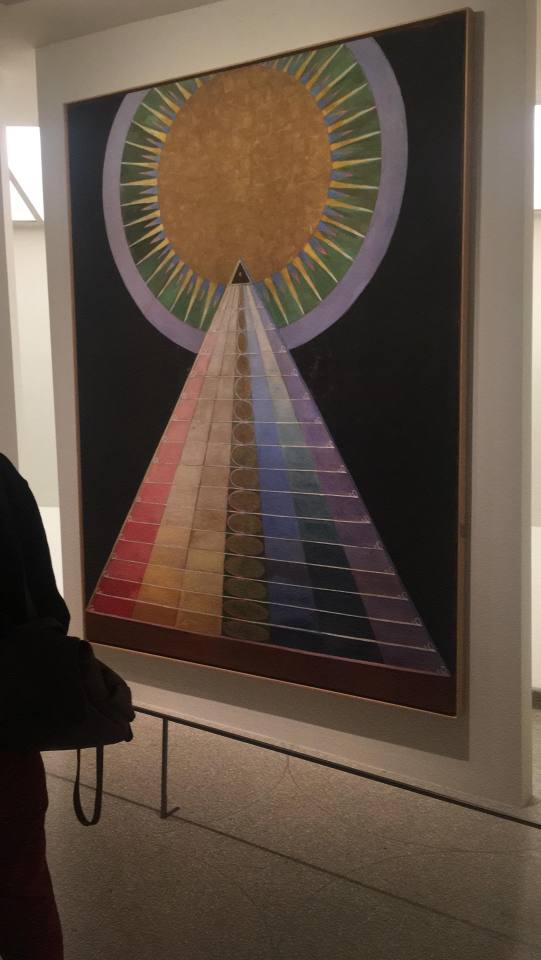
In the painting, the central circle with a small little man located in the middle, is trying to writes a meaning of a zygote, which is the beginning of the formation of not only the human embryo, but also the world conspiracy government (Illuminati) only with the eyes; which also is another symbol of a new beginning. However, it is challenging to deny the fact that the formation of the whole universe is presented only in the artist's work of art just as the main personification that is painting sessions of spirituality that she has experienced in the past. Not only did her painting is literally moving and pulling the audience into her story of life, but also the story itself touches the hearts of the audience in a way that is unforgettable.
0 notes
Text
11/28
Contemporary art would never stop surprised people. It is versatile, covers different aspects of using tools and materials, and includes itself multiple areas like science. With the help of science, artists can transform static sculpture into a dynamic system, which would be set in motion by the force of the elements and the laws of physics. Such kinetic sculptural systems attracted my attention in the Levy Gorvy gallery and the sculptor Alexandre Calder made me enter into a trance state by looking at magnificent aerodynamic mobiles. Seeing slow movements of lively works involuntarily reproduce memories from childhood, when as a child a viewer could see a similar pattern of objects over his crib. The aesthetic of minimalism abstraction catches the viewer's attention right after entering the gallery. The sculptor uses own balance of structures, the ratio of suspended and supporting elements to create weightlessness of an art object.
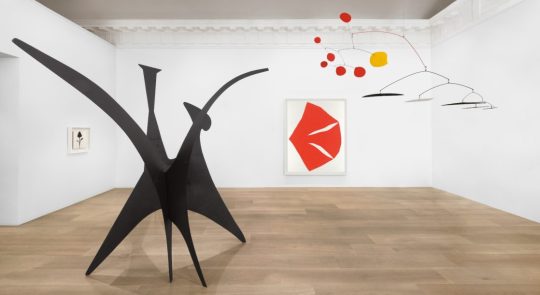
The representation of cartoon characters in an unusual way was already familiar to me. Brian Donnelly created a famous brand Kaws that many people desire to purchase. However, on a life-size scale, the sculptures represent soul agony of loneliness, like a giant electric blue character sitting alone on a white rectangular allegedly questioning himself about existence. The pain of loss also is shown in the installation; grey Mickey Mouse look-alike holding his friend, stepping one leg forward as almost asking for help and at the same time acknowledging the implication of occurring. The artwork brings association with famous Pieta, but the artist claimed that he did not think about Michelangelo’s piece during the creation of his own. Donnelly represented a specific way of demonstrating dark actions in a colorful form as almost showing a person with struggles that will not admit them in front of a public.

Lisa Yuskavage's paintings for this time were intensely vivid and expressed more sense of memories rather than seemed to be on the point between a reality and a dream, like after the first observation of her works. The installation talks to the viewer about a male-female relationship where love interferes with lust and happiness are replaced by hopelessness. During the exhibition's visit, I had feelings of watching melancholy movies about different couples. Every canvas wanted me to hear an untold story that was hidden from prying eyes.


Almost collage paintings of James Rosenquist made me feel a part of the pop art period. The talented artist was collecting in a single unit taken out of the context of pieces that are not related to each other. He skillfully combined or contrasted them, creating semantic compositions. Vivid canvases were almost screaming at the audience with their bright colors that made them look like billboards. Most of all I was attracted to the picture where the artist depicted three horizontal stripes, two of them in black and white, the bottom is bright, and color. Inanimate objects of technology and mass consumption with fragments of human faces and bodies made a strange world here – glowing and monumental, but at the same time frighteningly aggressive. James Rosenquist was able to portray contrasts and sharp transitions from one piece to another with a special grace that does not irritate the viewers' eyes.
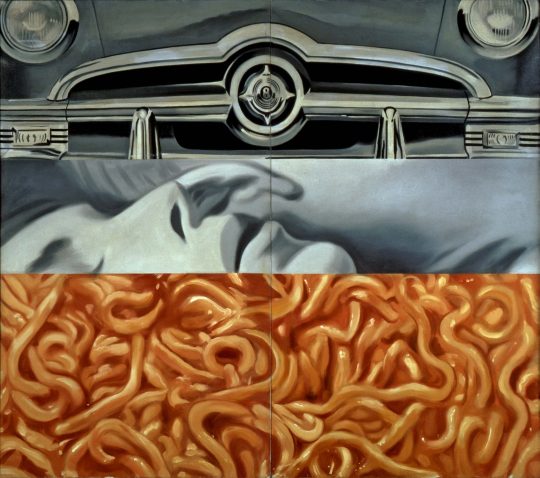
0 notes
Text
11/16
On Friday, November 16th our group re-acquainted with some galleries in Chelsea with the help of Eleanor Heartney, who is a contributing editor for Art in America and the author of Art & Today. Mainly, I appreciated the talent of the artist, which exhibition we saw the very first. The peculiarity of Lisa Yuskavage is that she depicts a kind of female nudity, but filling it with new freshness and value, so it does not look pornographic, at first glance. Each work is a challenge to the debate about the relevance or, on the contrary, the insignificance of nudity in contemporary art. Strange connections, shapes, and scenes are necessarily fragile landscape. Her works look like a dream or a vision because of its lightness and perhaps the small size of the canvases, which in my sense already creates the effect of tender.
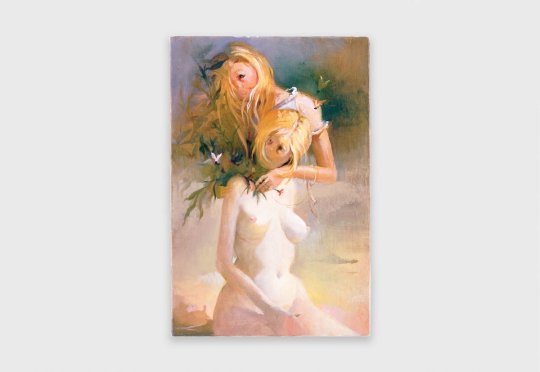
However, even though the paintings look innocent, they are depicting young teenage girls, consciously made by and for the erotic gaze of the voyeur, concentrate on creating this fantasy through a specific act of looking. Peeping, and in particular the look that catches the body of a young girl is, apparently belongs to both men and women. The pictures of Yuskavage are not only criticizing voyeuristically the desire to possess and to sexualize women's bodies, but also reveal the limitations of the intentional appropriation of "the image of Lolita" of women and young girls. Her paintings, however, suggest that the ability to captivate the force that is believed to manifest in the awareness of looking at yourself is celebrated because a human cannot distance themselves from the desire and power to look their physique. However, if the society allows women to be "watchable" by others, then the society would allow for the power to be contained in the hand of "watcher" of women's physique.
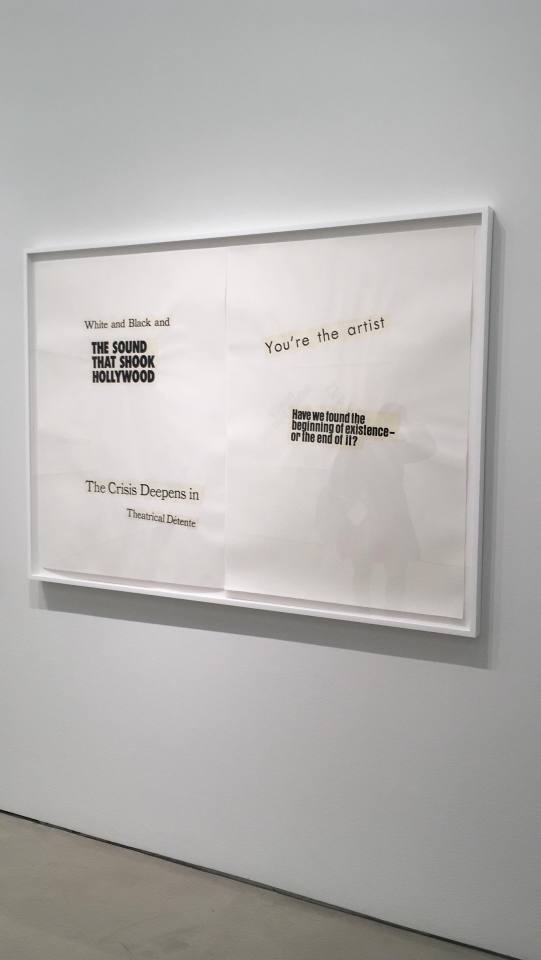
At the end of the day, I enjoined completely different exhibition of a New York-based artist Lorraine O'Grady entitled «Cutting Out CONYT.» Her canvases remind me a book of poetry because of the using compilation of extract from newspapers for collages. The artist herself calls her pieces “haiku diptych” where poem itself is represented in couple lines. Her works have the presence of contrast in a choice of using strong words and the juxtaposition between them, and I believe it is a reference to yin and yang that is why the installation is shown with white as paper backgrounds with black writing on them. These differences exist because of the bridge that is connecting her early works with new ones. The audience can see two voices with differing views that developed through her art career.
0 notes
Text
11/14
Contemporary art evokes ambiguous emotions. Skeptics roll their eyes, not allowing even the thought that this kind of culture can have some value. However, someone has the opposite opinion and does not get tired of admiring the new view of the creators and the conceptuality of his or her decisions. Netherveless, I believe that the art of this British artist and sculptor will not leave anyone indifferent. Sarah Lucas built her works on three aspects - sexual relations, death, and destruction. The artist seems to balance on the verge of foul and humor using the unusual materials for her creativity. She uses as her tools everything that comes to hand: cigarettes, rabbit fetus (if I understood right one of the sculptures), toilet, and pantyhose. The space that the artist makes between her pieces creates the chaos and misunderstanding of a composition. I guess in her sculpture works Lucas tries to develop sensitivity and to remove the hostility between people. Her actions are very candid and challenging to get used to them, some of them might seem offensive for religious people, like in the work of crucified Jesus made out of Marlboro cigarets, but the cigarets here represent the metaphor of death. Also, her sculpture should be perceived as a profound criticism of the society's perception of a woman's image and her sensuality in addition to creating sculptures, Sarah Lucas is quite successful in the genre of self-portrait and video making. I enjoined a lot the artist and her partner’s collaboration, especially Sausage film where she brings the idea of sexual stereotypes of women in the modern society. The show was very intense to look at, and sometimes I saw in the context of her works dark thoughts of reflection when a person on edge between life and death, which was hard to take. More excessive works I observed looking at Eugene Richardson's pictures, that showed me the cruel reality of life within an hour. The way that he represented people in his documentary footage amazed me, and I keep thinking about them. Building a strong relationship between posing person and a photographer must be extremely hard. Moreover, Richardson seemed amongst somewhere behind a camera. All these intimate moments with drug addicts and their families, war participants, hospitalized people, a father who just found out his son died in the war, a mother who devoted all her time to her son with a severe brain injury - look extremely real as I just heard their stories and felt their pain. They have shared their sacred moments with the artist, and he grants their tragedies with dignity. The most reliable connection I saw between him and his first wife during her battle with breast cancer, probably because they went together through the tragedy and he felt unconscious what how she wanted to tell the story. Eugene Richardson captured the truth of humanity in his every single work without any arrogance or trivialization; he presented the unvarnished stories that are needed to be heard.
0 notes
Text
11/9
I believe in a strong connection between an artwork and a viewer, and when an artist involves a viewer in his representation, the perception of work evaluation becoming different and accessible for understanding. As humans, we are familiar with aspects of the body and can have a different response to it or used materials, and when a body is an artwork itself the connection feels stronger, and it seems like a viewer can disappear in the art piece. On November 9th we saw an incredible show of Bruce Nauman in the new museum that belongs to MoMA, which was very shocking for me. I think Nauman’s work while remaining devoted to many Central themes, is incredibly diverse both in images and in ways of execution. He often repeats himself but does not reproduce the pattern. The artist uses new variations that are a part of the process of constant self-assessment and rethinking. He is a sculptor, but it is necessary to understand this word in the broadest sense: his works include not only objects made of metal, and latex, but also neon inscriptions, photographs, drawings, graphics, installations, performances, videos, sound recordings (which was very frightening) and texts. Nauman came to art after studying the Natural Sciences, and his artistic strategy can be described as constant experimentation (on himself, the viewer, the material) in search of possible forms of dialogue between them. Nauman probably wanted to be understood, but he was looking for the most effective ways to cause temporary insanity by causing discomfort to the viewer and turning aggression into creation. Apparently, because of the desire to be understood in the right way Nauman uses video and audio installation, where words and images he fills both physical and mental space, aiming to bring to maximum awareness understanding of its place in the system of values and coordinates of expectations from the world in general and the world of art in particular. In holographic works, the artist uses his face as a material, manipulating it like clay, and thus turns the human face into a work of art, presenting it as matter, but not as a specific person I experienced a strong connection with an artwork Live-Taped Video Corridor and Going Around the Corner Piece where I was involved in Nauman's piece. He used the phenomenology of the body in space with an element of simultaneous observation from the outside where the viewer can follow himself. Using simple-looking methods, the artist makes tangible in real area and time metaphor of observing yourself as if from the outside and the associated inability to catch the ever-elusive self-conscious. At the same time, the works serve as a real observation of the movements that a modern man should expect almost at every corner. Bruce Nauman made me disoriented in space but at the same time feel delving my, he used not only his body as a tool (like in contrapposto studies) but let people being part of his show, and it makes viewers admire the interaction where they can become a part of the installation. Mutual understanding exists between people entering the museum.
0 notes
Text
11/7
On November 7th I continued figuring out what real feminism is. Before moving to the United States I had minimum pieces of knowledge about the meaning of this word, for twenty years I have been taught that it is just a belief and I should know my genuine place in this world as a woman and don’t ask too many questions. Fighting the system seemed such an impossible thing for my understanding, and I have always been inspired by true fighters who did not care about the consequences but thought only about achieving the goals. Taking art history classes helped me a lot to see the whole picture of dishonesty that was surrounding me all this time. However, the controversy exists everywhere. I have learned that there are two sides to every story and the work of Judy Chicago is an example to it. The piece represents a triangular table with a length of approximately 14 meters.

The seats at this table are designed for great women and goddesses like the Amazon, Artemisia Gentileschi, Ethel Smyth, Virginia Woolf, and others. For each woman, a special plate with a three-dimensional image of the female genitalia, which displays the character of each guest, marks her place.
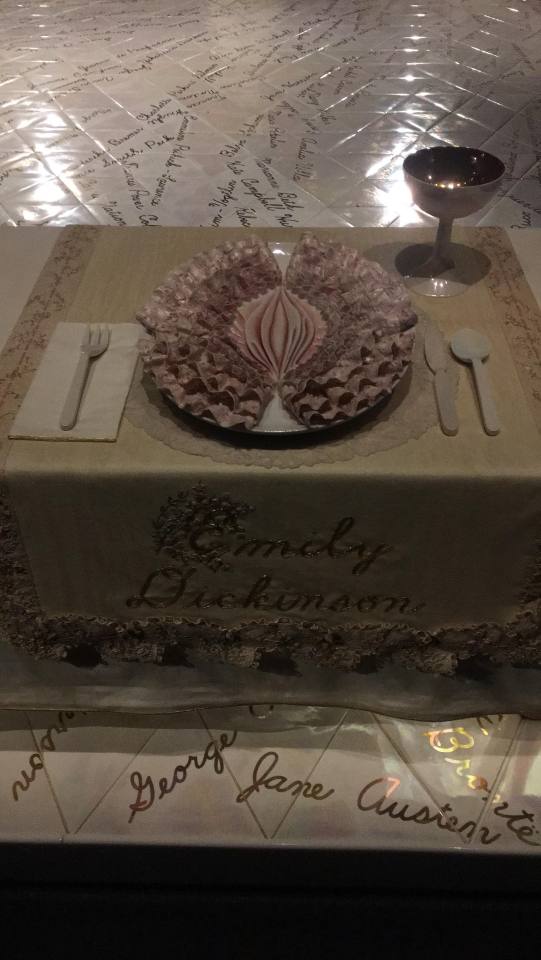
There are thirteen seats on each side of the table, and I think it is a reference to Leonardo da Vinci's Last Supper. Also, the triangle shape of the table in my point of view shows the condition of the hierarchy of white male dominance that a lot of male artists referred to in their work, like Rafael for example. However, the artist does not rethink the biblical story and changes the meaning of the dinner. The attention shifts from those who are present at dinner, on the food itself, which acts as female genitalia in a Patriarchal society, where "the place of women in the kitchen," the installation turns dinner into an event or a symbol of subordination of women, and asks questions about the power position of men.

The work was judged a lot at that period and was not always welcomed to be represented for the audience because of the “pornographic” contest, which I do not see. The installation represents parts of the woman’s body not in a sexual way, but the representation of the importance of a female in this world. There are several appreciations of a phallus in art trough years, but when the public sees the vagina even today, people will make a huge argument about this idea. Moreover, after that people still talk about equality in our lives.
In her work, Judy uses textiles, embroidery, porcelain painting, all that was considered a purely female art, in contrast to the fine arts, which has always been the dominance of men. However, the artist did not include many women in her work, and the white supremacy still exists in that art piece. Even though about 999 names are writing on the floor of the installation, it is still a floor that somehow shows the difference between “important” guests and just mentioned one. Although I have to understand the political difference of the time and that only wealthy white women fought for independence, since only they had the privilege for that, I still cannot say for 100 percent that I am satisfied with an idea of presented artwork.
0 notes
Text
10/19
The relationship between art and war, or art and terror, for instance, has always been ambivalent. Indeed, art requires peace and rest for development. The division of labor between war and art was quite clear, owning the fact that the warrior fought, and the artist depicted war. Thus, the artist and the warrior were interdependent. The warrior gave the artist a theme for art, but at the same time, he needed an artist as well since the artist could ensure the warrior fame and secure it in the memory of future generations.
Joseph Buckley’s “Traitor Muscle” sculpture depicts the relationship between grief and postcolonialism. This is a perfect example of a reminder of how cruel humanity is and can be. In addition, it depicts the reality of a world in which a greed driven society ultimately end in disparity rather than virtue. His work also shows the power and danger of the masses, as shown in the identical soldiers being stacked up as if they are some kind of product rather than human beings. It is the depiction of a dystopia in which we neglect the feelings of other and think of them as inanimate objects.

AN-MY LÊ on the other hand in her photo series about war makes the point that the stories told are often one-sided and fail to depict the commentary and holistic story. An-My Le took observation participants to stand as a photographer to rather than just being on the outside, she would experience it in its entirety. It is for the photographer and audience not interesting to look at the picture and only get their story, we want the artist’s perspective with it to fully understand the nuances of art. If we were interested in looking at one-sided stories we would look at Hollywood movies rather than go to a museum.
At the beginning of the day, we saw Randy Wray and his paintings with an overpowering use of the colors green and yellow. He is the perfect example of when the article of the most disgusting color of the world came out, Pantone 448 C. He exposes his audience to the things we dislike, see no value in, and would avoid on a day to day basis. His sculptures are constructed from material he finds at the beach or wood, he quite literally turns trash into art. Mr. Wray’s paintings leave the interpretation entirely to the audience, he even mentioned the interpretation of individuals to range from a uterus to mushrooms. His art is for you to admire and to seek redemption in the individuality of one’s own thought.
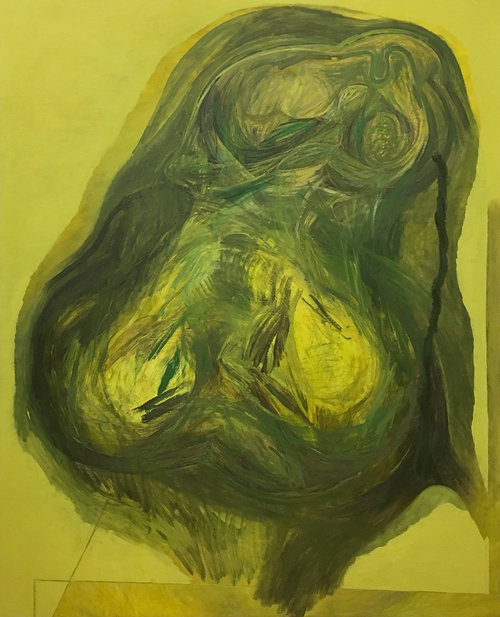
In the end, these artists all have a common goal which is to talk and depict macabre, ominous, and often disliked topics to the audience and start a conversation about these. War and its associations are disliked however it is the one-sided view that we are often left with, multi-directionality of opinions is key.
0 notes
Text
10/12
October 12th, 2018.
We are introduced to Katya Tepper’s work in the White Columns gallery, called Hysteric Signs. An appropriate name it is for the work she is displaying, it is messy, disorderly, and as she says; hysteric. Her work is a conglomeration of objects, individual trash, but in its totality show us the symbolism of society’s culture. It is the thought of ‘we make culture’ that is being displayed through the destruction that comes with culture. A thought to go with this exhibition is that Mrs. Tepper’s work tends to separate humans from nature, a debate that has been going on for quite a while. It is the original thought that because of our culture we urge ourselves that we, therefore, are not part of nature and that culture and nature are the extreme opposites, black and white. Finally, we are reminded that life is playful and that it is the hysteria of life that breaks us and makes us.

The next exhibition we look at is that of Dr. Lakra, is a beautiful example of Dadaism. The surreality of his paintings is not perceived initially, the audience only notices its disturbed reality when moving closer to the paintings. Furthermore, the paintings are a protest against the bourgeois and the world of academia. It probably is not malevolent, however, he tries to make the point that it is the people that scream the loudest and fastest are the ones that may not be right. His work reminds me of the Mutter Museum in Philadelphia in which we are offered a look inside the world of old-age physicians. Macabre is the right word to use when looking at this exhibition. Dr. Lakra’s roots are also in tattooing which makes sense with this display, tattoo artists often find themselves creating the ominous, evil of society and extrapolating the imagery to a caricature like depiction. His work is a potpourri of 1940s pin-up, tattoos, and extraordinary talent.

Last, it is John Ashbery displayed in Pratt Institute with his exhibition called The construction of fiction. John Ashbery, known to most as a great poet with humor this is also shown in this exhibition. The audience is being introduced to the creative process he went through as if he is holding our hands and leading the way. There is mockery, fun, realism, and randomization. Still, the interpretation of the audience is always lead to what Ashbery wanted us to understand. Another thing that is important is not only the individual art pieces but the installation work. The art is not hanging row in a row as often done, it has forms and movements that guide the eye towards the centers and the outer areas.
Collage and complexity was apparently the theme of the week.
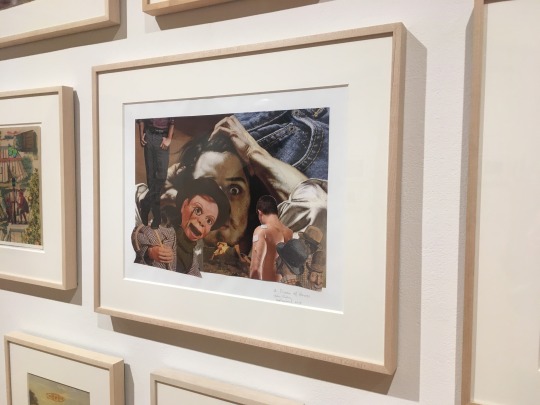
0 notes
Text
10/5
On October 5th we went to several galleries throughout Chelsea, New York City. Even though the theme of the week wasn’t clearly stated, for me the theme seemed to be human movement and kinesiology. It is the movement of humans and the interaction with inanimate objects.
The first gallery that I was very impressed by showed the work of Carmen Herrera in the Lisson Gallery. Her work displays a strict but playful way in which an artist can express herself by minimalism and colors. She shows that abstraction offers a sneak peek into the silent complexity of the human mind. We are offered simplicity but remain the feeling of complex layering. A similar technique we know is that of Piet Mondrian, as she states in her artist statement was of great influence on her work. His layering and creations that take the viewer on a quest to find convolution where most see a direct line. In her work she which she calls ‘my quest’ the coloring reminded me of the red line of life, as her paintings use red with confidence. Besides red coloring, she seems to display the extremes, black and white, blue and orange, or red against anything.

I’ve seen grey whale go by, the Gagosian gallery proudly presented the work of Mary Weatherford. Mrs. Weatherford seems to continue the impression of human movement and its movements in life. We are presented grotesque ambiguous forms on a large canvas and our eyes are lead by neon LED lighting. Similarly to Mrs. Herrera’s work, we are presented with a play on the human psyche as it seems. The figures we see are brutish, almost like the id as known by Freud is taking over, however, we are then drawn in and back by the neon light which seems to show tranquility, a neon (red) line guiding us to the end.

In terms of kinesiology, it is the last exhibition that makes you understand my introduction statement. Urs Fischer’s Play exhibition in the Gagosian gallery is the psyche and behavioral combination an artist can only dream of. Immediately catching the eye of the audience is his display of wheeled office chairs that are being rolled around. It is the energy that draws the viewer in, and the complex choreography that keeps you around, because to understand is to watch in this case. The second the viewer tries to interact with the chairs to understand, they are shown that the exhibition doesn’t do what the viewer wants, again reminding us that we don’t control our lives we just hope that it goes similar to what we want.
The theme of humans and objects, in this case, could also be interpreted as human beings and control over their life. There is no control and art shows us that no control can be okay and that to repress is often not living.

0 notes
Text
10/24
After reading Joseph Wolin's articles and our meating with him he explained what art criticism is about and how we should be thinking about critisizing art works. Mr. Wolin made a good point when talking about his former students in which they were not that fond of the work of Todd Hido's work and they explained that the work was not impressive and disliked by the group to which mr. Wolin disagreed. In the art world there will always be extreme binary opinions opposing each other; love and hate, black and white. However, I do think that anyone is entitled to their opinion but must be made to listen to the opinions of others.
The criticism of art is based on the interprettion of the public opinion's perspective of the art piece, the artist's own thought , feelings, and behavior, and the value given by the upper class and academics . We often fail to remind ourselves that the impact art has on our lives is completely based on our own perspective of the art piece and the way we later on use this impact in our daily life. From a symbolic orientation we could argue that it is the art and the symbols of our culture that create a harmony between our profane and sacred life as discussed in Durkheim's theory. The reason behind the art and rituals of society is to create the collective consciousness and the social cohesian bringing idividuals together. This is a symbol such as a the photographs by Leslie Tonkonow in which we get introduced to the importance of kinship relations and how the mother and child relationahip holds up for societies morals and values. Her work is also an introduction to neo-feminism in which we do not perceive the role of mother as an archaic stereotype but rather as an empowering role in the family. Simultaneously, the photographs are depicting a one sided perspective of motherhood in which motherhood is a dreamlike experience, however the photo series fails to depict the negative and sometimes even abuse sides of motherhood. For example postnatal depression etc. Still, there is honesty and that's what we should consider that not only the public's opinion is of importance when thinking about the art, but it is the artist that is expressing their personal experience to us and letting us get to know them little by little, picture by picture.
The criticism of art from the public is often also based in the misunderstanding of the public to perceive the real reasoning and intepretation of the art piece that the artist was trying to convey. Therefore, the exhibition of Wolfgang Tillmans's 'Rebuilding the Future' it is very interesting that one of the main reasons for his exhibition is to take the public on a journey to experience the development of the art pieces. The exhibition is depicted as the journey but clearly states the question at the end to the public between the fragility and the strength. The work is a metaphilosophical questioning about the existence of human beings and whether or not the role we play is the role we should play. It is open, questionable, but brutally honest in the end, therefore the name of the exhibition that implies: 'what is yet to come, and are we empowered or left fragile?'.
Todd Hido's work only takes one look and reminds us immediatly of the 80s sci-fi genre that introduced us to CGI for the first time. The blurry, ambiguous, and almost terrestrial impression we are left with in which we can only imagine what is yet to come. The photoseries is not there to give the audience the pleasure of concrete recognition, it is the dystopian sense of America with a hidden beauty of extrapolated colorization and omnious themes. The series is a nostalgic tribute to the horror/sci-fi movies we all grew up with ranging from Stephan King to the goonies, and even E. T. Even though the picture are incredible, the audience can't deny it's feeling of something lurking behind. It is like walking into new scenery and then being exposed to the female figurines whom are not showing their faces as if we need to look behind their backs to find what they are avoiding or ignoring. It is a psychological mind game that has it's highs and lows but for the audience it is a silent spectacle in which we are unaware of what the end spectacle should be except for the fact that we know there is more to come.
Coming back to the entitlement of opinions we finished our day in the modern art conservationalism. The recovery of the art after damaging in extreme realism is easier than when done in modern art, because in realism the message is often protrayed with more clarity wheras in modernist thematics it is the artist and the artist only that can recover the art piece. Still, they manage to convey and recreate the exact message as original from the artist. The conservation is an addition to the art rather than a restoration in my opinion, it gives the art its extra character even though we might not always perceive the restoration, there is still a sense of damage that evolves the art piece and adds to the story.
10/17 +500 for missed class.
0 notes
Text
10/10
On this hot beautiful day in Brooklyn, I discovered for myself the technique of prints in the studio of Yashua Klos, which opens a new gate for unique ideas that are very motivational. The studio brings the inspirational feelings because it is located in the artist's apartment and it was something new and fascinating for me; I have never seen any working places that also combines with a living room. I assume that this area contributes to differences in creation because he lives there and works there, meaning all his ideas are being created right there where they were generated. It brings unlimited time; this method actually allows his thought flow to produce his art pieces, which is very intriguing because it shows authenticity and creativity of the artist.
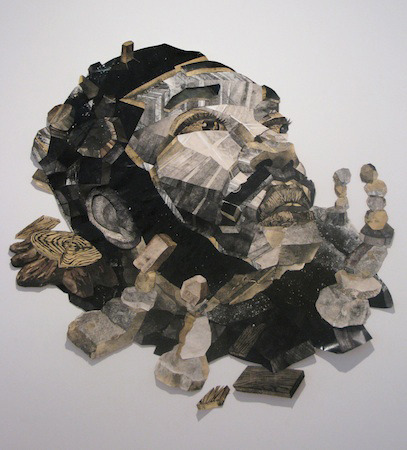
The works of Yashua Klos is very personal to him. It is based on racial identity and its experience as an African-American / biracial person. Klos grew up on the south side of Chicago, and I believe he creates such prints for showing the world, for example, the violence problem. He takes pictures of people from his surroundings and then using photoshop to transfer prints to the canvas itself. In his compositions he represents that personify issues of today's society. The faces on Klos’ scenes look as if they are trying to escape from some dangerous consequences that they did not have the intention for. I loved how he is distinguishing facial features where a viewer can see every detail and these details provide the audience with a story that is hidden behind.

It was interesting how in one day we had two artists with two different concepts if Yashua Klos recreates community's outcomes Julia Bland weaves large size tapestries that will make a person to be distracted from the outside world. When I was standing next to her art objects, I felt if someone looks deep inside the carpets for a long time, the process of meditation will appear in one's mind. The geometric repeating pattern makes a viewer to get lost in the subject; a carpet with an elaborate ornament is ideal for meditation in the order that it can be viewed endlessly, plunging into patterns, spreading out with thought and concentrating on it. The subjects on the tapestries reminded me much cosmic alien stuff because of triangle diagrams that appear in her works not only once.
If talk about similarities in two artists' studios I would say that the presence of home is the one them. Klos lives in his working space, but Bland creates tapestries that is a perfect and self-sufficient work of art, it is at the same time very functional in the home. It warms the floors and walls, serves as a bedspread for the sofa and tablecloth, making the house cozy. The carpet perfectly organizes, structures the space, denoting zones, emphasizing the forms of furniture, harmonizing and contrasting with them. Almost everyone in the class has noticed the practical and warm meaning of her art pieces.
(pictures were taken from the artists' sites as an example)
0 notes
Text
10/03
Nowadays, contemporary art has many directions and styles, which is why artists sometimes have to stand out from conventional ideas and create relatively new things in order to be sold on the market. I believe that keeping up with progress is one of the main attributes in the modern world and the creation of art pieces in digital form using information technology is one of the best ways to draw audience’s attention and to sell the works.

Trisha Baga’s exhibition stole my heart, especially her three-dimensional short film, everything in the room helped to immerse in navigation between virtual and actual world. I think that the clock on a wall was on purpose as a reminder about fast passing times that we do not notice in the order that visual and audio technologies are slightly taking us away from the reality, so we have to stop sometimes, look at the time and convince ourselves to reconsider valuable things in life.

In my opinion, the fact that all the money was donated afterward to the Climate Justice Alliance making Baga a living example that her installation was about how important is to know consequences in reality. Her hologram series of pictures about deceases affection reminded me of Wojnarowicz using same elements in his works, and I feel like it was made in a way to distinguish a particular problem in the story that been told in the picture.

I enjoined a lot Petah Coyne installation «Having Gone I Will Return» because of the confident gothic mood, feelings between death and life. The sculpture in her show have narrative story about grief or last goodbye, and I think here the object that attracts people's attention is velvet material because it helps the audience to feel this farewell since we all know what it feels like to the touch, but inability to touch it in the gallery is, so the presence of life disappearance exist in the room. The stuffed birds that were made out of real feathers make the image of the exhibition more somber, for the reason that these beautiful swans look such an actual creat realization that these fake creatures convey the fullness of the installation.

The most favorite part of the day for me was seeing Judith Bernstein's studio, I love how she expresses her opinion free without fear of being judged, I saw everything that I expected to see: the expression of women's anger through the paintings, the madness of this world, the cold truth of reality, provocation. Bernstein set as her goal asymmetrical response to the objectification of the female body, deciding in her painting to objectify the male. The neon colors in the artist pieces attract the viewer to the part where you need to focus. The images are almost vibrating from the canvases, radiating light, and the names of the works help to understand the importance of the topic that Bernstein wants to bring, from my perspective it is a significant point to have a contrast from other artists.

0 notes
Text
09/21
As an international student, I was excited to visit “Whitney” because it is actual new American history, an extraordinary place with avant-garde art. Whitney Museum of American Art was conceived to support American artists. Now it contains the largest in America collection of paintings, sculptures, graphics and art installations of the XX-XXI centuries. The building itself looks incredibly glorious and modern, when we went outside of 7th floor, in front of me were opened incredible views, it seemed that I was on another planet. After the reading about an American artist David Wojnarowicz, I wanted to see his art, especially when I have already heard about his performance where he sewed his mouth in protest against a government that did not support HIV-positive people. I was pleasantly surprised that his art a whole floor to himself.
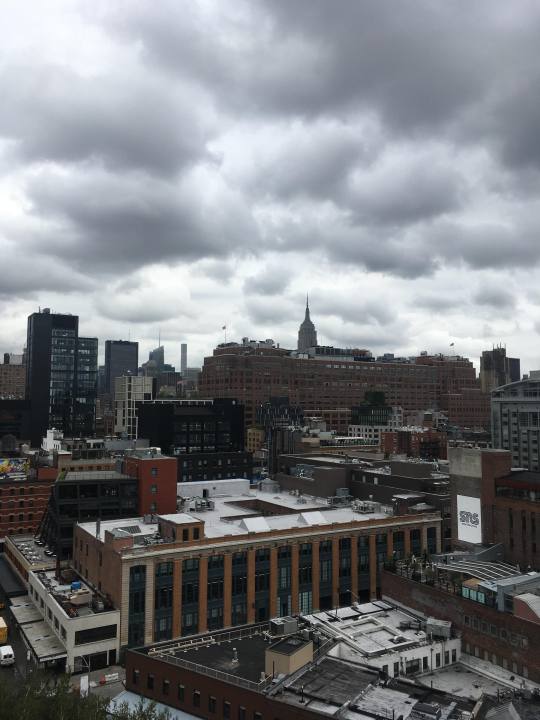
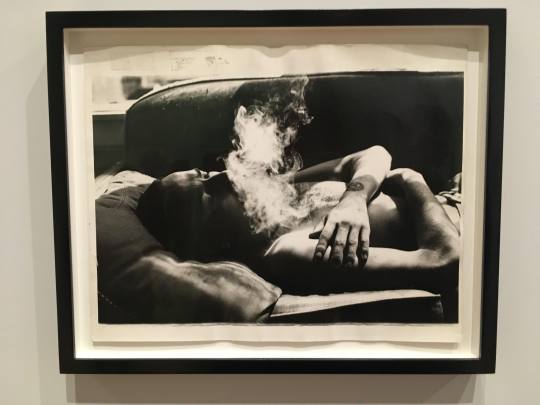
I want to mention the work of his band, their music reflects life in New York in the 80s, going into the room with his collage works, music and a film about a shooting, I seemed to get into the time machine and found myself there along with the famous scandalous artists. Also, I was very touched by the room where I could sit down and listen to his debate. In the late 1980s, the artist found out that he has AIDS. Since that time, he dedicated his art to fighting for his human rights. He launched a broad debate on censorship, the legal rights of the artist, medical care, and the problems of sexual minorities. His works of that time reflect the unusually tricky condition of the artist. So on one of the photos he made shortly before his death, he depicts his face, almost entirely covered with earth - a kind of mask of death.
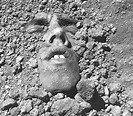
For the first time I saw someone using a hologram on the painting, it was on the «Newspaper as National Voodoo: A Brief History of the U.S.A» picture, the work includes sports articles and, apparently, national songs with a hidden meaning. The doll represents connected with veins to nature, so the painting shows how everything affects the formation of history. The hologram depicts a suffering Jesus, in general, Wojnarowicz very often denotes religion in his works but compares it with contemporary problems like in a collage with French novelist and poet Jean Genet, who was a political activist and had an addiction to heroin. David made him as an icon and added a figure of a Christ injecting drugs, and explained that drug addiction is a contemporary struggle that an empathetic Christ with and forgive.


After the museum we went to High Line Park, it is located on the site of an abandoned railway and looking around, it seemed to me that houses from the futuristic movies surrounded me. Implemented by New York architects and landscape designers, the project appears unusual - in part, they kept railroad tracks, and along the promenade road, trees and shrubs are planted on both sides. Thus, the architects achieved a unique combination of nature and industrial motives.
0 notes
Text
09/14
The first museum of contemporary art that I visited not in New York City became Dia: Beacon in which I hope I will come back and more than once, it was a love from the first sight. Dia: Beacon - a museum of contemporary art in the town of Beacon on the banks of the Hudson. The museum renovated from the former box-printing facility. The scale of the space is impressive and admirable. The rooms in the museum are large, minimalistic, filled with light and air. The museum space is almost entirely illuminated naturally, the light is soft and spread everywhere. This museum is not only about art as about space. And space there is magnificent!

In the two largest halls, Walter De Maria laid out hexagrams from an ancient Chinese book of philosophy and divination, and these sculptures with perfect measurement plunged me into a meditation condition. In the beginning, I tried to find a coded phrase or to understand a meaning of letters, but then our students told us that this is the way people do readings about the future in Asian culture, that is why red carpets were chosen for distinguishing the iconographic meaning of the sculptures.

I have been already delighted to see of Dan Flavin's light installation work in Judd's house, and in Dia: Beacon he has multiple installations which I was very glad to observe. Light and color are strong emotional stimuli and creators of the artistic image. Light and color can expand and deepen the space, structure it, set the rhythm, fill with air. Flavin uses this at full capacity. And the angular small compositions and the works with a large scale are equally expressive. It is very interesting how under certain lighting fluorescent light changes its color.

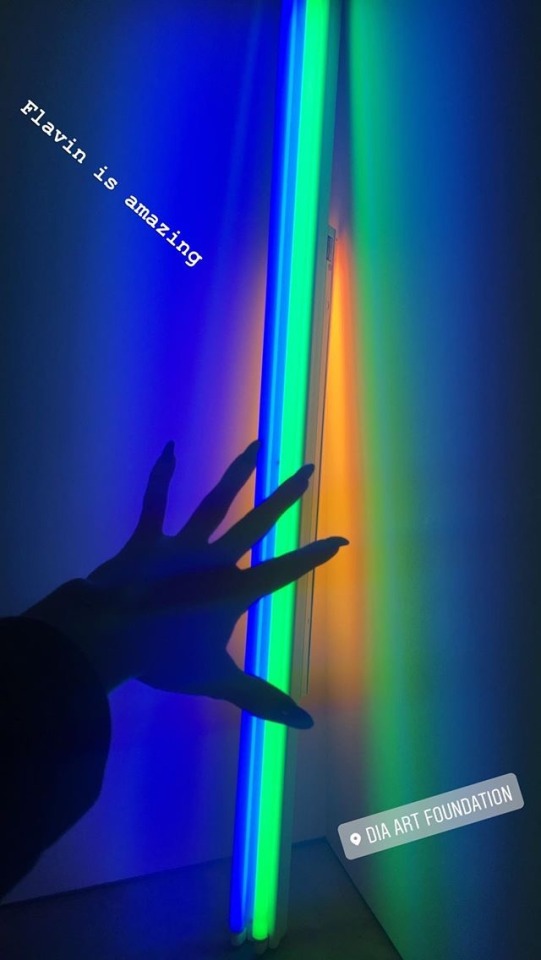

This work cannot be approached, unfortunately. The work belongs to Michael Heather. His "North, East, South, West" was designed back in 1967 and waited for implementation only in the new museum. Four geometric figures are embedded in a concrete floor at a six-meter depth, forming geometric pit-traps if the viewer looks inside he will be able to see this trap. Standing at the edge, I experienced an actual fear of falling, but the barriers did not let me come closer.

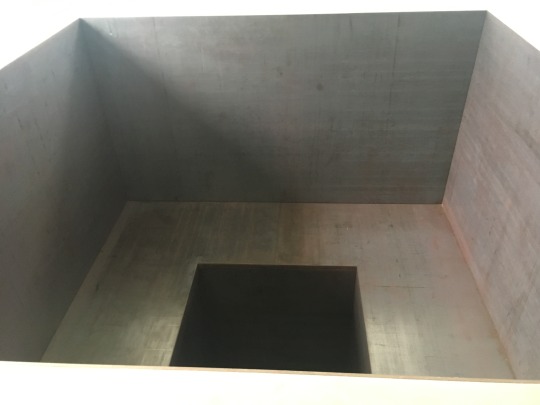
In On Kawara works, which I spoke about in the previous post, the viewer can forget oneself because here the artist has a hall and many of his paintings are placed there. Looking at the dates you forget about where you are, you only think about your life now, trying to remember the moments that happened on that particular day, that is some metaphor when our lives represent art themselves. I tried to find my date of birth. (Unfortunately, I forgot to take a picture).
Donald Judd laid new foundations in the study of volume, interval, space, and color. He rejected traditional forms and used industrial materials. Focusing on the size, the presence of the structure and area around, Judd's work draws attention to the relationship between the object, the viewer and the environment.
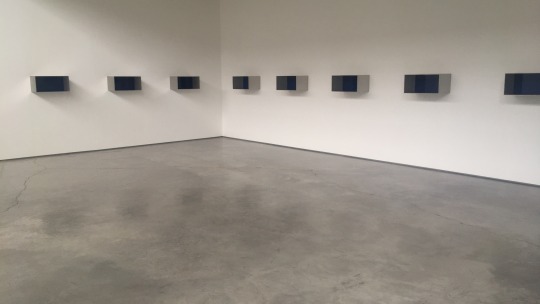
0 notes
Text
09/07
The second day of art semester I missed the scheduled train, so I had to get to the MoMA myself which was an entirely of a challenge for me, New York subway is extremely complicated for a person who saw a subway only in visiting cities. I was very excited to see Helen Levitt’s works, and fortunately, I made it right in time when it was a discussion about her photos.
American artist Helen Levitt is one of the most celebrated female photographers of our time. I am fascinated by the way she observes the social life of middle-class people, Levitt depicts genuine emotions of children, mothers, passers-by. The photograph is not a dispassionate mirror of the world, an artist in photo art can express his relation to the phenomenon embodied in the picture through the camera angle, the distribution of light, light, and shade, the transfer of the originality of the representation, the ability to choose the right moment of happening things. Taking pictures is especially hard when a photographer works in a genre style like Levitt. In many of her works, there is a mystery, a kind of trap for the viewer, who is curious to know what people are so passionate about at this moment in the photo. Looking her pictures over and over again, the viewer might find new exciting details that allow a completely different look at each work and somehow rethink the plot embedded in it. My favorite work of hers is from 80’s, not a colorful picture of two men talking, it is interested me because I wonder what are they discussing so severe, why are they in the line, is it a line or just a crowded place, why the men on the front have some stick in his jacket. I feel like black and white picture conveys more emotions or mood than a colorful one.

Also, I enjoined sculptures of another American artist David Hammons, his idea of creating circles reminds me of the infinite life or cycling in nature when he reuses garbage making a fantastic art, this makes the viewer think about the human uses in nature, because the majority of our population only destroys it without doing anything in return.
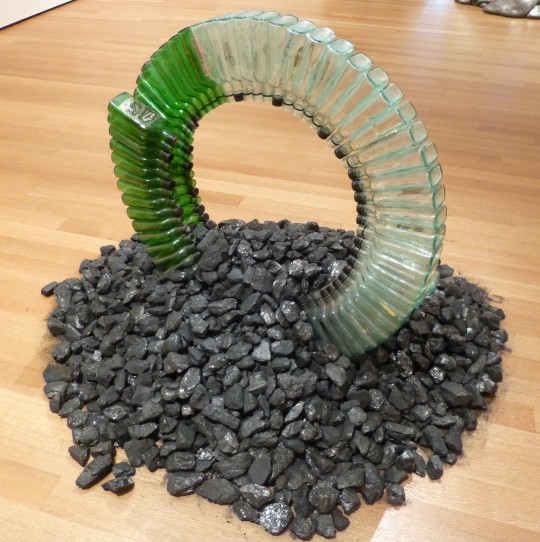
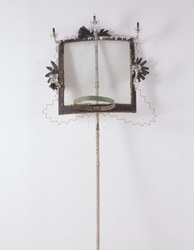
The works of the Japanese artist On Kawara made an indelible impression on me. His picture consisted only of the date on a monochrome black background. Every time the artist traveled somewhere, he created the image in exactly the style in which the date was written in the local newspaper, apparently the painting that represented in MoMA he created in the United States because of the way of using the date. If he did not manage to finish the picture before noon, he destroyed it. On Kawara very carefully makes the paintings, they consist of 4-5 layers, devoid of individual handwriting. I liked the way he presented the pictures in the boxes covered with the inspired newspapers. It is unfortunate that the museum does not show it.

0 notes
Text
09/12
Enjoying a picturesque canvas or an impressive sculpture in a museum or gallery is one thing, but a completely different impression can produce on the viewer in the interior, in the atmosphere where art was created. Fortunately, the houses and studios where prominent artists lived and worked have reached us and are open to visitors. Visiting such places helps to feel the spirit of that time, to understand the artist, his character and life. One of these open houses is located in New York in Soho and belongs to an American artist, who associated with minimalism, Donald Judd. He left for an open public his loft building that nowadays represents as a museum of his works and other artists of that time. He lived there from 1968 to 1972. Previously, in this five-floor house, built in 1870 by architect Nicholas White, was a garment factory. Buying a house, Judd first thought only of the workshop, but then decided to settle here and exhibit works. Judd occupied all the floors entirely, and they are filled with works of the artist, furniture of legendary modern designers and old objects, such as a bureau and a cast-iron stove. This house is like a giant installation in which the artist lived. This building is without internal partitions. Judd always took into account the properties of space in which he demonstrated his objects - his proportions, illumination, and surface properties. His "specific objects" were not sculptures in the traditional sense. His works did not represent anything; they were just objects in space. Moreover, the space they created - negative space - was just as much a part of the sample as the object itself.
The creation of space is one of the characteristics of minimalist art. Another American artist Walter de Maria plays with a sense of space as well. The works of de Maria seem at first glance to be dry conceptualism - metal bars laid out in a particular order in the hall, brilliant details, similar to dentures, an even layer of earth covering the floor of the gallery. However, the main work in the works of de Maria is not the material form, and the experience that the viewer receives - and in this experience, and not in metal or earth, is the essence of the artist's works. His perfect art piece "the broken kilometer" impresses with its scale. This work is a meditation in the form of pure mathematics. It makes the viewer renounce the diversity of everyday life and focus on the simple, exactly measurable roulette basis of our ideas about space, any viewer who enters this space can interact with him only in one way: by silent contemplation. His extraordinary work “the earth room” also causes the viewer to get into the trance because of the strong smell of damp everywhere and a presence of nature inside an industrial building. The impression remains complete, but there is not a single image in it, only the adoption of abstraction, this artwork is both alive and dead.
0 notes
Text
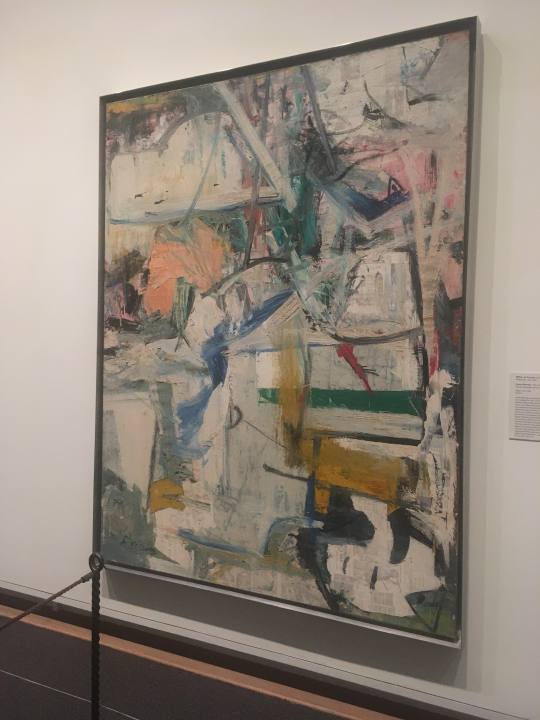
+500 words for a missed class on 09/19
9/5



Art is a reflection of reality in artistic images. That is, this is the reality that we are experiencing, but submitted through the interpretation of the artist. Nowadays, it is difficult to understand contemporary art. If earlier there was always one style, for example, baroque, and the leading artists made art precisely in this manner, now there is no particular style. So every person, an artist, tries to express himself uniquely. He is trying to do what nobody has done before.
I believe that there are artists who study social processes, and the results of their studies they show in their work. For understanding this direction of art, the viewer needs to know the theoretical basis. The artist expresses some idea; usually, it is somehow justified, and this idea needs to be known in order to understand the essence of what is happening. Also, other artists express their emotions, themselves, their feelings, experiences. Here already there is no theoretical basis. Here everything is calculated for emotions.
The installation for the Metropolitan Museum of Art «we come in peace» by Huma Bhabha, features two cast bronze sculptures, has a social message. Bhabha’s work addresses themes of colonialism, war, displacement, and memories of the place. Using found materials and the detritus of everyday life, she creates haunting human figures that hover between abstraction and figuration. (https://www.metmuseum.org/exhibitions/listings/2018/huma-bhabha). The place of the exhibition was not chosen by chance, we can clearly see how “simple people” (the sculpture wearing a trash bag on a body) worship “the saviors” who seems kind and coming in peace, but if you walk around multiple faced creature you will see how twisted this sculpture is (it appears only behind the statue in a way to show us hidden faces of “the people above us”). The worship occurs in the direction of modern skyscrapers while freestanding sculpture is facing towards untouched nature (such as parks), as a reminder to a viewer what colonialism and capitalism represent, showing the value of money. The work retains the look of the used materials, but now it conveys a spirit of desperation and pleas for help.
The sculpture illustrates the idea that art can potentially transform into society, depicts a massive introduction into a non-cultured or poorly civilized country of immigrants from a civilized state. In order to understand this work the viewer should know some information about colonization itself, otherwise, he will see two big sculpture standing next to each other. That is why it is hard to understand the contemporary art because now the artists have no boundaries, but only the idea of creating a piece that will convey a particular thought.
On the other hand, there are works of art where the artist expresses his emotions, and we do not need theoretical basis, for instance, Jackson Pollock and his big abstract expressionism canvases. His style is recognizable; Pollock created a fundamentally new technique of painting, consisting in an apparent-chaotic spray of colors. He spread giant canvases directly on the floor and dripped paint on them, without touching the surface with a brusher, thus expressing his feelings and emotions in these, as it might seem at first, meaningless smears. However, the longer a viewer looks at the picture, the more stories he sees in his head. All these brushstrokes appear in various visions. It seems like the artist feels the space of the canvas when creating his paintings. There are no explanations here, and everyone has their vision on this matter. Unbridled, unpredictable energy comes from this combination of geometric planes and shapes.
Another example of expressing feelings is Willem de Kooning with an unusual presentation of the art of abstraction, where the forms are half dissolved in raging expression. Only now it is not chaotic spraying colors technique, but he started with the drawing, then applied the paint, again drew - already on top of the paint, added some images from other works, again paint, scraped something, drew something. The artist dissolved the relationship between the foreground and background and using paint to create emotional, abstract gestures, using ribbon-like passages through which straight lines can float or abruptly stop and balance on vast open areas, or crowded, bold, lyrical spaces. Brightly colored, predominantly linear elements are compared with thinly toned white areas. Ultimately, the viewer observes the variety of images that everyone sees differently depending on the mood or imagination. The title helps to see the whole picture, but it is not so concreated as in the piece I described above. The attempts to convey their truth and self – that is how I see the difference now between the works in contemporary art.
Contemporary artists, as well as the artist of different times, want to depict the world as it looks today. In the late 20th century they created photorealism where their goal was to depict the world not just reliable, but superreal. There is another category of art – where the emotions and the social message coexist together. Photorealism has set itself the task of sharpening our perception of everyday life, symbolizing the modern environment, reflecting our time in the forms of “technical arts” widely spread precisely in our era of technological progress. In the Met, I was very interested in Chuck Close’s works; on the way, he represents his art. Chuck Close’s pieces differ from traditional painting in that photographs execute all paintings. Polaroid snapshot is transferred to the canvas, which then is delineated on a grid of squares where certain boundaries of tonal transitions are noted. Then the master paints acrylic paints with a brush, drawing circles and filling the space on the canvas with juicy, bright colors.
It should be noted that this technique allows the artist to achieve a 3D effect and the reality of the image. This method accurately conveys the character of the person depicted on the canvas. Through such works, the viewer also sees the emotions that the artist wanted to convey, and can see the reality displayed by the time.
1 note
·
View note